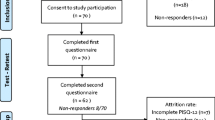Abstract
Introduction and hypothesis
The aim of this study was to validate a self-administered version of the already validated interviewer-administered Australian pelvic floor questionnaire.
Methods
The questionnaire was completed by 163 women attending an urogynecological clinic. Face and convergent validity was assessed. Reliability testing and comparison with the interviewer-administered version was performed in a subset of 105 patients. Responsiveness was evaluated in a subset of 73 women.
Results
Missing data did not exceed 4% for any question. Cronbach’s alpha coefficients were acceptable in all domains. Kappa coefficients for the test–retest analyses varied from 0.64–1.0. Prolapse symptoms correlated significantly with the pelvic organ prolapse quantification. Urodynamics confirmed the reported symptom stress incontinence in 70%. The self and interviewer-administered questionnaires demonstrated equivalence. Effect sizes ranged from 0.6 to 1.4.
Conclusions
This self-administered pelvic floor questionnaire assessed pelvic floor function in a reproducible and valid fashion and due to its responsiveness, can be used for routine clinical assessment and outcome research.

Similar content being viewed by others
References
Baessler K, O'Neill SM, Maher CF, Battistutta D (2009) Australian pelvic floor questionnaire: a validated interviewer-administered pelvic floor questionnaire for routine clinic and research. Int Urogynecol J Pelvic Floor Dysfunct 20:149–158
Bump RC, Mattiasson A, Bo K, Brubaker LP, DeLancey JOL, Klarskov P et al (1996) The standardization of terminology of female pelvic organ prolapse and pelvic floor dysfunction. Am j Obstet Gynecol 175:10–17
Koch GG, Landis JR, Freeman JL, Freeman DH Jr, Lehnen RC (1977) A general methodology for the analysis of experiments with repeated measurement of categorical data. Biometrics 33:133–158
Bland JM, Altman DG (1986) Statistical methods for assessing agreement between two methods of clinical measurement. Lancet 1:307–310
Gill TM, Feinstein AR (1994) A critical appraisal of the quality of quality-of-life measurements. JAMA 272:619–626
Kazis LE, Anderson JJ, Meenan RF (1989) Effect sizes for interpreting changes in health status. Med Care 27:S178–S189
Katz JN, Harris TM, Larson MG, Krushell RJ, Brown CH, Fossel AH et al (1992) Predictors of functional outcomes after arthroscopic partial meniscectomy. J Rheumatol 19:1938–1942
Amarenco G, Arnould B, Carita P, Haab F, Labat JJ, Richard F (2003) European psychometric validation of the CONTILIFE: a quality of life questionnaire for urinary incontinence. Eur Urol 43:391–404
Shumaker SA, Wyman JF, Uebersax JS, McClish D, Fantl JA (1994) Health-related quality of life measures for women with urinary incontinence: the incontinence impact questionnaire and the urogenital distress inventory. Continence Program in Women (CPW) Research Group. Qual Life Res 3:291–306
Kelleher CJ, Cardozo LD, Khullar V, Salvatore S (1997) A new questionnaire to assess the quality of life of urinary incontinent women. Br J Obstet Gynaecol 104:1374–1379
Jackson S, Donovan J, Brookes S, Eckford S, Swithinbank L, Abrams P (1996) The Bristol female lower urinary tract symptoms questionnaire: development and psychometric testing. Br J Urol 77:805–812
Kulseng-Hanssen S, Borstad E (2003) The development of a questionnaire to measure the severity of symptoms and the quality of life before and after surgery for stress incontinence. Bjog 110:983–988
Bug GJ, Kiff ES, Hosker G (2001) A new condition-specific health-related quality of life questionnaire for the assessment of women with anal incontinence. Bjog 108:1057–1067
Reilly WT, Talley NJ, Pemberton JH, Zinsmeister AR (2000) Validation of a questionnaire to assess fecal incontinence and associated risk factors: fecal incontinence questionnaire. Dis Colon Rectum 43:146–153 discussion 153-4
Barber MD, Kuchibhatla MN, Pieper CF, Bump RC (2001) Psychometric evaluation of 2 comprehensive condition-specific quality of life instruments for women with pelvic floor disorders. Am J Obstet Gynecol 185:1388–1395
Lukacz ES, Lawrence JM, Buckwalter JG, Burchette RJ, Nager CW, Luber KM (2005) Epidemiology of prolapse and incontinence questionnaire: validation of a new epidemiologic survey. Int Urogynecol J Pelvic Floor Dysfunct 16:272–284
Abrams P, Avery K, Gardener N, Donovan J (2006) The international consultation on incontinence modular questionnaire: www.iciq.net. J Urol 175:1063–1066; discussion 1066
Avery KN, Bosch JL, Gotoh M, Naughton M, Jackson S, Radley SC et al (2007) Questionnaires to assess urinary and anal incontinence: review and recommendations. J Urol 177:39–49
Barber MD, Walters MD, Bump RC (2005) Short forms of two condition-specific quality-of-life questionnaires for women with pelvic floor disorders (PFDI-20 and PFIQ-7). Am J Obstet Gynecol 193:103–113
Price N, Jackson SR, Avery K, Brookes ST, Abrams P (2006) Development and psychometric evaluation of the ICIQ vaginal symptoms questionnaire: the ICIQ-VS. Bjog 113:700–712
Avery K, Donovan J, Peters TJ, Shaw C, Gotoh M, Abrams P (2004) ICIQ: a brief and robust measure for evaluating the symptoms and impact of urinary incontinence. Neurourol Urodyn 23:322–330
Cotterill N, Norton C, Avery KN, Abrams P, Donovan JL (2008) A patient-centered approach to developing a comprehensive symptom and quality of life assessment of anal incontinence. Dis Colon Rectum 51:82–87
Kirshner B, Guyatt G (1985) A methodological framework for assessing health indices. J Chronic Dis 38:27–36
Guyatt G, Walter S, Norman G (1987) Measuring change over time: assessing the usefulness of evaluative instruments. J Chronic Dis 40:171–178
Norman GR, Sridhar FG, Guyatt GH, Walter SD (2001) Relation of distribution- and anchor-based approaches in interpretation of changes in health-related quality of life. Med Care 39:1039–1047
Lydick E, Epstein RS (1993) Interpretation of quality of life changes. Qual Life Res 2:221–226
Wyrwich KW, Bullinger M, Aaronson N, Hays RD, Patrick DL, Symonds T (2005) Estimating clinically significant differences in quality of life outcomes. Qual Life Res 14:285–295
Norman GR, Wyrwich KW, Patrick DL (2007) The mathematical relationship among different forms of responsiveness coefficients. Qual Life Res 16:815–822
Norman GR, Sloan JA, Wyrwich KW (2003) Interpretation of changes in health-related quality of life: the remarkable universality of half a standard deviation. Med Care 41:582–892
Conflicts of interest
None.
Author information
Authors and Affiliations
Corresponding author
Additional information
The validation of the self-administered pelvic floor questionnaire without sensitivity to change was presented at the Annual Meeting of the International Continence Society in 2004, Paris (podium presentation; extended abstract): a validated female pelvic floor questionnaire for clinicians and researchers. Baessler K, O’Neill S, Maher C, Battistutta D. Neurourol Urodynam 2004; 23: 398–399.
Appendix
Appendix
Self-administered Australian pelvic floor questionnaire: please note that the numbers for scoring have been included to facilitate the interpretation of the questionnaire. When applying this questionnaire to a patient, the numbers should be replaced by boxes to avoid any bias.




Rights and permissions
About this article
Cite this article
Baessler, K., O’Neill, S.M., Maher, C.F. et al. A validated self-administered female pelvic floor questionnaire. Int Urogynecol J 21, 163–172 (2010). https://doi.org/10.1007/s00192-009-0997-4
Received:
Accepted:
Published:
Issue Date:
DOI: https://doi.org/10.1007/s00192-009-0997-4




